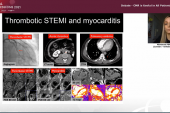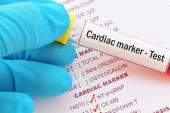Myocardial Injury Tied to Greater Mortality 1 Year After COVID-19 Hospitalization
“Long COVID” symptoms and readmissions also tended to be higher at 6 months among patients with troponin elevations.

Patients who have myocardial injury—indicated by elevated high-sensitivity cardiac troponin T (hs-cTnT) levels—when hospitalized for COVID-19 are more likely to die within the first year and may be at risk for having ongoing symptoms for up to 6 months, a prospective, single-center study suggests.
Compared with patients with undetectable troponin levels during the initial hospital stay, those with at least one hs-cTnT measurement of 14 ng/L or more had a significantly higher mortality risk (HR 13.76; 95% CI 1.85-102.29), though patients with lower levels of troponin detected did not (HR 2.31; 95% CI 0.27-19.48), according to findings published last week in the Journal of the American Heart Association. Most deaths occurred during the index hospitalization.
Moreover, patients with myocardial injury tended to have higher rates of readmissions and ongoing COVID-19-related symptoms, although the differences didn’t reach statistical significance after accounting for potential confounders.
“Our findings add to the limited data that previously existed showing that patients with evidence of myocardial injury during the index hospitalization had an increased risk of cardiac, thrombotic, and infectious complications during the hospitalization and all‐cause mortality,” lead author Brittany Weber, MD, PhD (Brigham and Women’s Hospital, Harvard Medical School, Boston, MA), told TCTMD via email.
A “unique aspect of our cohort findings which surprised us,” Weber said, was that was that mortality out to 1 year among patients who survived to hospital discharge was low, even if they had myocardial injury.
“These data suggest that patients who are hospitalized with COVID‐19, even if critically ill, but survive the index hospitalization are likely to survive up to 1 year,” she said. “However, these patients do have trends towards higher rates of hospital readmissions and postacute sequelae of COVID‐19 at 6 months, an important focus of future work.”
‘Long COVID’ Symptoms Common
Prior studies have shown that myocardial injury is common in patients hospitalized with COVID-19, and is associated with greater risks of dying during the initial admission and up to 6 months later. But less clear are the implications for longer-term mortality risks and for other outcomes, including readmissions and postacute sequelae of COVID-19, or “long COVID” symptoms.
For the current study, Weber et al turned to the prospective Brigham and Women’s Hospital COVID-19 registry, examining data on 483 patients (median age 63 years; 50.5% women) with confirmed SARS-CoV-2 infection who were hospitalized in the initial months of the pandemic (March to May 2020) and had hs-cTnT levels available. Most patients (62.3%) had cardiac injury, defined as a troponin level of at least 14 ng/L at some point during the hospital stay. Another 25.5% had lower levels of troponin detected and 12.2% had no troponin detected.
During the initial hospitalization, which lasted a median of 9 days and involved a stay in the ICU for 45.8% of patients, thrombotic, infectious, and CV complications were frequent, observed in 14.4%, 24.0%, and 25.6%, respectively. Rates of all outcomes were higher in those with myocardial injury.
Mortality was consistently higher in patients with elevated hs-cTnT levels over time. In-hospital, 6-month, and 12-month mortality rates were 28.6%, 32.2%, and 33.2%, respectively, among patients with myocardial injury and 4.1%, 4.9%, and 4.9%, respectively among those with lower levels of troponin detected. No patients with undetectable levels died during the study.
Overall, 81.2% of patients survived the initial hospital stay, including 377 who had at least some postdischarge follow-up (median 170 days). Nearly one-quarter of these patients (24%) were readmitted at least once within the first year, with 9.6% of those return trips involving thrombotic complications and 29.8% involving cardiac problems. About two-thirds of readmitted patients had had myocardial injury during the index hospitalization, although an elevated hs-cTnT level was not independently associated with a greater risk of readmission (HR 1.5; 95% CI 0.8-2.5).
Of patients who survived to discharge, 211 had a detailed clinical assessment performed at 6 months to look for postacute sequelae of COVID-19. Overall, 37.0% had ongoing symptoms, including dyspnea, chest pain, fatigue, palpitations, loss of smell or taste, and headaches. And compared with their preinfection state, 19.9% had worsening functional status, 16.1% had neurocognitive decline, and 3.8% had an increase in supplemental oxygen requirements.
Though differences based on the presence of myocardial injury were not statistically significant, the prevalence of ongoing COVID-19-related symptoms at 6 months was highest in those with elevated hs-cTnT levels (56.4%), followed by patients with lower levels of troponin detected (30.7%) and undetectable levels (12.8%).
Remaining Questions
One big question that remains involves the mechanism underlying the link between myocardial injury and poorer outcomes in patients with COVID-19, the investigators say. “However, this association has previously been seen in patients with other infections, such as influenza, and other noncardiovascular disease states,” they note. “Hs-cTnT likely serves as a subclinical marker of cardiac damage in response to these conditions, with higher levels associated with a greater degree of damage.”
They indicate that additional research is needed to better understand the impact of myocardial injury in COVID-19.
“More in-depth diagnostic evaluation with cardiac imaging and further biomarker analysis across the wide range of disease states associated with elevated hs-cTnT could provide further understanding of the myocardial function and structural changes that lead to the adverse outcomes and increased mortality,” they write.
It’s difficult to know, too, whether these findings, derived from data on patients hospitalized during the first 3 months of the pandemic, are generalizable to patients today considering changes over time in treatments, vaccines, and viral variants, Weber acknowledged. “However, if a patient is sick enough to require hospitalization and has evidence of myocardial injury, then this still likely portends a worse prognosis and could suggest a relationship to longer post-COVID symptoms.
Commenting for TCTMD, Annapoorna Kini, MD (Icahn School of Medicine at Mount Sinai, New York, NY), whose group also has studied myocardial injury in the setting of COVID-19, questioned whether the results remain applicable to the current situation, pointing out that initial indications are that Omicron-infected patients are not becoming as acutely ill as those sickened by prior variants. Myocardial injury seems to be less prevalent, too, she said.
Like the investigators, Kini said the exact mechanisms involved in the relationship between myocardial injury and poor outcomes in COVID-19 patients remain unknown. “But we all know if they have a large myocardial injury, the outcome is bad,” she commented.
Thus, the question of how to follow these patients becomes important. Kini said her center has a general medical clinic for patients with COVID-19 and a cardiology clinic for those with myocardial injury, at which patients are followed with laboratory testing and echocardiograms. But there is a need for consensus guidance on the best way to monitor these patients postdischarge and whether more-advanced imaging is needed, she stressed.
This is an important area for future studies, according to Weber. “Specialized centers are focusing on the longitudinal care of patients with longer-term symptoms postrecovery, and some patients require follow-up imaging and lab testing,” she said. “Whether each patient who had myocardial injury but fully resolves symptomatically post-COVID requires follow-up monitoring and imaging is still an active question which is the focus on many ongoing research investigations, including one we are just about to start assessing the relationship between prior COVID-19 infection and coronary microvascular dysfunction using cardiac PET.”
Todd Neale is the Associate News Editor for TCTMD and a Senior Medical Journalist. He got his start in journalism at …
Read Full BioSources
Weber B, Siddiqi H, Zhou G, et al. Relationship between myocardial injury during index hospitalization for SARS-CoV-2 infection and long-term outcomes. J Am Heart Assoc. 2021;10:e022010.
Disclosures
- This research was supported by the National Heart, Lung, and Blood Institute.
- Weber and Kini report no relevant conflicts of interest.





Comments